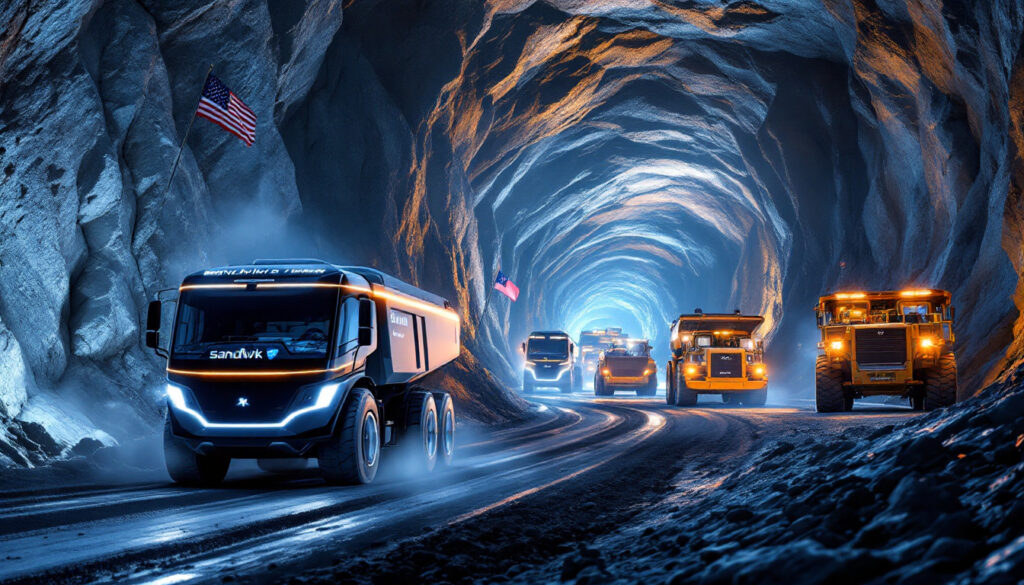What is the $120 Million Sandvik-South32 Mining Equipment Deal?
The landmark $120 million agreement between Sandvik and South32 represents one of the most significant investments in mining electrification technology to date. This comprehensive deal will supply a diverse fleet of mining equipment to support South32's Hermosa critical minerals project in Arizona, a development with far-reaching implications for sustainable mining practices in North America.
The contract encompasses both battery-electric vehicles (BEVs) and conventional mining equipment, with deliveries scheduled to begin in Q4 2026 and continue through 2030. This timeline strategically aligns with Hermosa's production commencement target of 2027, ensuring the equipment is deployed in coordination with mine development phases.
As Mats Eriksson, President of Sandvik Mining and Rock Solutions, explains: "Lower fuel expenses and maintenance costs coupled with longer equipment lifespan will enable a more efficient, economical and sustainable mining operation at Hermosa." This statement underscores the dual benefits of the deal: economic advantages for South32 and environmental sustainability improvements for the mining sector.
The magnitude of this equipment order reflects both companies' commitment to advancing sustainable mining technologies while addressing critical mineral shortages in the United States.
Why is the Sandvik-South32 Equipment Order Significant?
Record-Breaking Battery-Electric Vehicle Order
This agreement marks the largest battery-electric vehicle order in Sandvik's corporate history, signaling a watershed moment in mining industry electrification. The unprecedented size of this BEV purchase demonstrates major mining companies' growing commitment to electric equipment solutions, with South32 positioning itself at the forefront of this transformative shift.
The scale of investment—$120 million—reflects confidence in BEV technology's maturity and economic viability for large-scale mining operations. Industry analysts note that this order could accelerate BEV adoption across the sector, as other mining companies observe South32's implementation strategy and results.
According to mining equipment market projections, the global mining BEV market is expected to grow at a compound annual growth rate (CAGR) of 14.2% between 2023 and 2030, with approximately 60% of mining firms aiming for 30% BEV fleet penetration by 2030.
Strategic Importance for Critical Minerals Supply
The Hermosa project holds particular significance as currently the only advanced mine development project in the United States capable of producing both manganese and zinc—two minerals designated as critical by the federal government due to their importance to national security and economic prosperity.
This strategic value is amplified by the fact that the U.S. currently imports approximately 95% of its manganese requirements, creating significant supply chain vulnerabilities. Hermosa's development directly addresses this dependency by enhancing domestic production capacity for these essential industrial materials.
Eriksson connects this equipment deal directly to "increased supply of critical minerals" and "electrification of society," highlighting how mining equipment modernization contributes to broader technological and economic transitions.
The U.S. Department of Defense classifies zinc as "critical" for military alloy production, further emphasizing Hermosa's strategic importance beyond commercial applications.
What Equipment is Included in the Sandvik-South32 Deal?
Battery-Electric Vehicle Fleet Components
The agreement includes a comprehensive range of battery-electric mining equipment:
- Electric-powered mining trucks for ore transportation, featuring regenerative braking systems that recover energy during descent
- Battery-electric loaders with advanced digital monitoring systems for material handling operations
- Electric bolters designed for enhanced precision in ground support installation
- Battery-powered development drills optimized for tunnel creation in confined spaces
- Electric longhole drills for production drilling with reduced noise and vibration signatures
Sandvik's BEV trucks boast impressive specifications, including payload capacities of up to 65 tons for models like the TH665B. These vehicles utilize lithium-ion battery systems with 8–10-hour operational cycles, allowing for continuous operation across mining shifts.
Conventional Equipment Components
While electrification is a central focus, the agreement also includes traditional equipment for specific applications:
- Diesel-powered trucks for operations where battery range limitations present challenges
- Conventional cable bolters for specialized reinforcement operations
- Standard loaders for supplementary material movement needs
- Traditional longhole drills for specific production drilling requirements
This blend of electric and conventional technologies creates a practical transition strategy, ensuring operational continuity while maximizing electrification benefits where most advantageous.
How Will This Equipment Transform the Hermosa Project?
Economic Benefits for South32
The financial advantages of this equipment investment extend far beyond the initial purchase:
- Reduced fuel expenses: Complete elimination of diesel costs for BEV units, delivering immediate operational savings
- Lower maintenance costs: BEVs require approximately 30% fewer maintenance hours compared to diesel equivalents due to their simplified drivetrains and fewer moving parts
- Extended equipment lifespan: Sandvik estimates BEV operational life exceeds diesel equivalents by 15–20%, improving long-term return on investment
- Enhanced operational efficiency: Instant torque delivery and improved operator conditions contribute to productivity gains
- Regulatory compliance advantages: Future-proofing operations against increasingly stringent emissions regulations
BloombergNEF research indicates that BEVs can reduce underground mining costs by $5–10 per ton, creating substantial savings over Hermosa's multi-decade operational lifespan. Industry analysts project a payback period of 5–7 years for South32's $120 million equipment investment.
Environmental Sustainability Improvements
The environmental benefits of this equipment selection are equally compelling:
- Significant emissions reduction: Complete elimination of diesel particulate matter and exhaust gases in underground environments
- Decreased ventilation requirements: BEVs reduce ventilation energy costs by up to 50% in underground mines, creating substantial operational savings
- Reduced heat generation: Lower thermal signature of electric equipment minimizes cooling requirements
- Noise pollution reduction: BEVs operate at approximately 70 dB compared to 90 dB for diesel equivalents, improving communication and reducing occupational health concerns
- Alignment with corporate sustainability goals: Supporting South32's broader environmental commitments and mining ESG challenges
These environmental improvements have been demonstrated at other mining operations. For example, Goldcorp's Borden Mine in Canada reported 70% lower greenhouse gas emissions after transitioning to battery-electric equipment, providing a real-world case study for the benefits South32 can expect at Hermosa.
"The elimination of diesel particulate matter in confined underground spaces represents one of the most significant occupational health improvements in modern mining," notes a recent Journal of Mining Engineering study, highlighting the human health benefits beyond environmental considerations.
What is the Timeline for the Sandvik-South32 Equipment Deployment?
Delivery Schedule
The equipment deployment follows a strategic timeline designed to synchronize with Hermosa's development:
- Initial equipment deliveries beginning Q4 2026
- Majority of units scheduled for delivery during 2026–2027
- Continued phased deliveries through 2030
- Timeline carefully coordinated with Hermosa's production commencement in 2027
This phased delivery approach mitigates supply chain risks while ensuring operational readiness by Hermosa's production target date. Industry data indicates BEVs typically have longer lead times (12–18 months) compared to conventional equipment (8–12 months), making advance planning crucial for project success.
Project Development Synchronization
The equipment delivery schedule is meticulously coordinated with Hermosa's development phases:
- Early equipment arrivals support construction and pre-production activities
- Strategic deployment prioritizes critical path operations
- Commissioning and training periods incorporated into the timeline
- Long-term maintenance and support programs extending throughout project ramp-up
This synchronized approach ensures maximum equipment utilization throughout the mine's development cycle, optimizing South32's capital investment while maintaining operational flexibility.
What Makes the Hermosa Project Strategically Important?
Critical Minerals Production Capacity
Hermosa stands as a uniquely valuable asset in America's critical minerals landscape:
- Exclusive production profile: Currently the only advanced U.S. mine development project capable of producing both manganese and zinc
- Strategic mineral supply: Addressing critical gaps in domestic supply chains for battery manufacturing and industrial applications
- Exceptional longevity: Projected operational lifespan exceeding 30 years
- Near-term production: First mineral production targeted for 2027
- Supply chain resilience: Potential to significantly reduce U.S. dependency on imported critical minerals
The U.S. Geological Survey reports that domestic production of manganese currently meets less than 5% of U.S. demand, highlighting Hermosa's potential to transform America's critical mineral self-sufficiency. The project's zinc production similarly addresses supply chain vulnerabilities for this essential industrial metal.
Economic Impact on Arizona
Beyond national strategic importance, Hermosa promises substantial regional economic benefits:
- Job creation: Over 500 direct jobs during peak operations, with additional indirect employment effects
- Infrastructure development: Road, power, and water improvements benefiting surrounding communities
- Tax revenue generation: Projected $200 million annually in state and local tax contributions
- Skills development: Transfer of advanced mining technology expertise to local workforce
- Downstream opportunities: Potential catalyst for battery manufacturing and critical mineral processing facilities in Arizona
The Arizona Commerce Authority has highlighted Hermosa as one of the state's most significant mining investments in decades, with economic impacts extending far beyond the immediate project area.
How Does This Deal Reflect Industry Electrification Trends?
Mining Sector Transformation Indicators
The Sandvik-South32 agreement exemplifies broader mining industry trends toward electrification:
- Accelerating adoption of battery-electric vehicles for underground operations
- Major mining companies prioritizing sustainable equipment investments to meet ESG targets
- Equipment manufacturers scaling up electric vehicle production capacity
- Increasing economic competitiveness of battery-powered mining equipment
- Technological advances in battery density, charging infrastructure, and autonomous capabilities
According to PwC's Mining Survey, approximately 68% of mining executives now consider fleet electrification a strategic priority, up from just 32% five years ago. This reflects both environmental pressures and recognition of operational benefits.
Competitive Advantages of Electrification
Mining companies pursuing electrification gain multiple competitive advantages:
- Air quality improvements: Elimination of diesel particulates creates healthier working environments
- Operational cost reduction: Total cost of ownership analysis increasingly favors BEVs over diesel alternatives
- Productivity enhancements: Reduced ventilation downtime and improved operator comfort boost output
- Maintenance simplification: Fewer moving parts and simplified drivetrains reduce maintenance complexity
- ESG alignment: Meeting investor and regulatory expectations for environmental performance
Rio Tinto's Gudai-Darri mine in Australia provides a compelling case study, having reduced diesel consumption by 20% through strategic deployment of battery-electric equipment similar to Hermosa's planned implementation.
What Specific Benefits Will Battery-Electric Vehicles Provide at Hermosa?
Operational Advantages
The battery-electric vehicles deployed at Hermosa will deliver specific operational benefits:
- Zero emissions underground: Complete elimination of diesel particulate matter in confined workspaces
- Reduced thermal load: Lower heat generation minimizing ventilation requirements
- Enhanced communication: Noise levels approximately 20dB lower than diesel equivalents
- Improved responsiveness: Instant torque delivery enhancing productivity in demanding conditions
- Energy recovery: Regenerative braking capturing 15–20% of energy during descent operations
These operational advantages translate directly into productivity improvements. Sandvik's white papers indicate that BEVs can reduce cycle times by 5–10% compared to diesel equivalents in typical underground mining applications.
Maintenance Efficiencies
The maintenance profile of BEVs offers substantial advantages:
- Simplified service requirements: Up to 50% fewer moving parts requiring regular maintenance
- Extended service intervals: Longer periods between major maintenance activities
- Reduced fluid management: Virtual elimination of engine oil, coolant, and transmission fluid changes
- Enhanced diagnostics: Advanced telematics enabling predictive maintenance strategies
- Specialized training opportunities: Development of high-value electrical maintenance skills
"The maintenance simplicity of battery-electric vehicles represents one of their most underappreciated advantages," notes Sandvik's recent white paper on mining equipment trends. "Beyond the environmental benefits, the reduction in maintenance complexity creates operational efficiencies that directly impact mining economics."
Frequently Asked Questions About the Sandvik-South32 Deal
What makes this equipment order unique?
This represents Sandvik's largest-ever order for battery-electric vehicles, valued at approximately $120 million, demonstrating a significant commitment to digital mining transformation by both companies. The scale and comprehensive nature of the order—covering multiple equipment categories—sets a new benchmark for mining equipment purchases.
When will the equipment be delivered?
Deliveries will begin in Q4 2026 and continue through 2030, with most equipment arriving in 2026-2027 to align with Hermosa's production timeline. This phased delivery approach ensures equipment availability synchronizes with mine development stages.
Why is the Hermosa project significant?
Hermosa is currently the only advanced mine development project in the U.S. that could produce two federally designated critical minerals—manganese and zinc—making it strategically important for domestic supply chains. With America currently importing 95% of its manganese requirements, Hermosa represents a crucial step toward mineral security.
What economic benefits will the battery-electric vehicles provide?
The BEV fleet will deliver lower fuel expenses, reduced maintenance costs, and longer equipment lifespan, creating a more efficient and economical mining operation at Hermosa. Industry analysis indicates potential operational cost reductions of $5–10 per ton compared to conventional diesel equipment.
How does this deal reflect industry trends?
This major investment in battery-electric mining equipment demonstrates the accelerating shift toward decarbonisation in mining, driven by economic, environmental, and operational advantages. Industry projections suggest BEV adoption in mining will grow at a CAGR of 14.2% through 2030.
Furthermore, the Sandvik and South32 mining equipment order showcases how digital twins for mining are becoming integral to modern mining operations, with advanced monitoring systems that optimize performance and reduce maintenance needs in real-time.
Want to Invest in the Next Major Mineral Discovery?
Discovery Alert's proprietary Discovery IQ model instantly notifies investors about significant ASX mineral discoveries, transforming complex data into actionable insights that can give you a crucial market advantage. Understand why major mineral discoveries can lead to significant market returns by exploring Discovery Alert's dedicated discoveries page, showcasing historic examples of exceptional outcomes.




